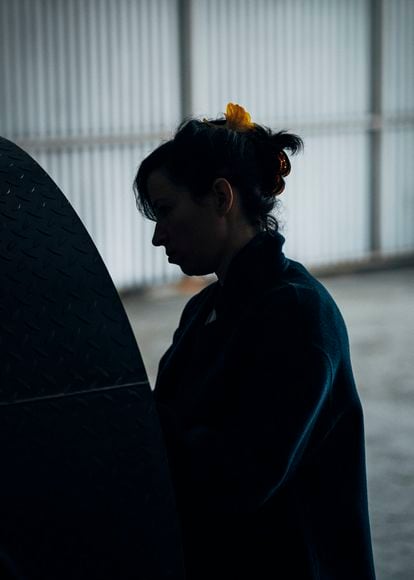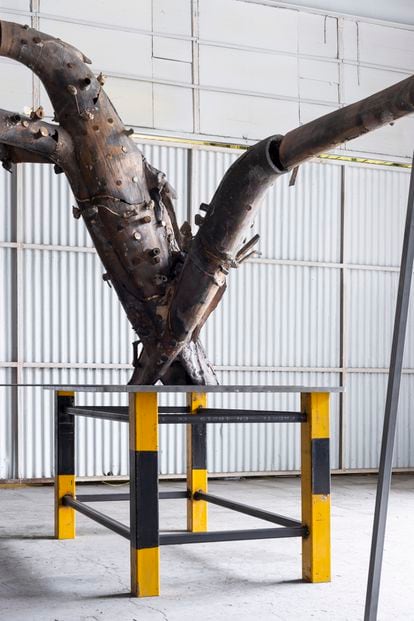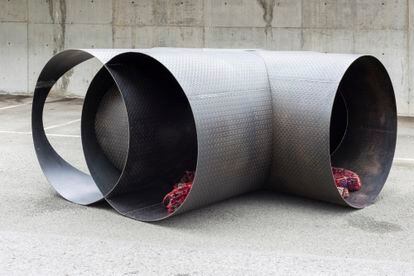A doing that while doing invents a way of doing. This pun defines the work of the sculptor June Crespo (Pamplona, 42 years old) so well that it has been attributed to her on occasion, when it comes to a quote from the Italian philosopher Luigi Pareyson. It suggests that the process by which something is achieved already has result value. And it destroys the idea of the artist as a genius moved by infallible truths, greater than himself, which has operated from Michelangelo to Picasso. In his studio in a neighborhood of Bilbao, weeks before the big moment of the inauguration of Vascular, her exhibition at the Guggenheim Museum in Bilbao (from March 1), June Crespo takes on Pareyson's words. “They speak very accurately about what I experience in my artistic practice,” she explains. “I proceed from trial and error, with uncertainty and failures. Chances, calculation errors, often determine the final shape.”
It is unusual for a Spanish artist of her age to have a solo exhibition at the Guggenheim dedicated to her. She speaks with conviction, but without emphasis or pompous formulas. The floweriest thing that comes out of her mouth is: “It's nice to find what you wanted after taking an unexpected detour, so you better go for that adventure.” Adventure, not challenge. “At first I called it that myself, challenge, but now I try not to do it,” she says. “When we talk about challenges we tend to push things without leaving room for the unknown. I work differently. As if she were an assistant in the way that has to arise, instead of me demanding that she satisfy my wishes.”
He has based almost all of his artistic practice on sculpture, which was already emerging as his natural field since he was studying Fine Arts at the University of the Basque Country in the early 2000s: “In it I saw a stimulating mystery because it was a path not traveled that was very attractive to me.” The classes with Professor Ángel Bados, one of the most influential artists on the Basque art scene, a fundamental figure in the new Basque sculpture that emerged in the 1980s, were decisive. “I liked the way he accompanied us, more than teaching us, so that we found our way of doing things,” Crespo recalls. “Later I discovered that it was a back-and-forth process because he was also permeable to our work. “I understood it by experiencing it myself, when I have taught classes.”
It would be too easy an exercise to consider it one of the last stations on a path of modern Basque sculpture that, starting from Oteiza and Chillida, would generate a straight line with Bados himself, and then Marisa Fernández, Pello Irazu, Txomin Badiola, Sergio Prego or Ibon Aranberri. “Of course you feel part of something, because it's what you bring from home,” he reflects. “I feel respect for the artists who have preceded me, but also for colleagues close to me. Everything makes up a network with which I talk.”

That network comes up frequently in conversation. When we talk about her experience at the 2022 Venice Biennale, where she was one of the only two current Spanish authors selected by curator Cecilia Alemani (the other was Teresa Solar), she cites the Polish artist Aneta Grzeszykowska, who shared space with her: “The coexistence with his works was very exciting for me. Venice was a learning experience in which I tried to give my best. And the feedback Afterwards it was good, I was very happy.” Likewise, she highlights the respect she feels for other generation colleagues, such as Julia Spínola or Elena Aitzkoa.
His sculptures, which bring together a wide diversity of materials and often orchestrate encounters between opposites—the soft and the hard, the organic and the industrial—present a deceptively unfinished appearance that can refer to the idea of rubble. Even when the reference is the human body, as in his series Helmets and Cheek to Cheek. Crespo always starts from observing what is around him. Radiators, pipes, mannequins, flowers. “Sometimes, when I put the things I collect together, I feel the desire to do something with them,” he says. “I work a lot from molds, variations or repetitions. Sometimes the source of inspiration is my previous practice, and the result is something better than what I projected.” A doing that while doing invents a way of doing.

An experience that marked him was his time at the De Ateliers artistic residency, in Amsterdam, between 2015 and 2017. “It was a very rich period, which generated many encounters with artists from different generations and
origins,” he recalls. “The Basque Country is a place of reference artists, with a lot of commitment and seriousness about their work, and that has shaped me. But, at the same time, one can be a little limited by that context. Going out was a way to facilitate changes, to give myself permission to incorporate other ways of doing and thinking. When I returned, I returned to the type of pieces that I had previously done here, which had another affectivity, something warmer.”
There will be news at the Guggenheim. Several of the new sculptures, produced specifically at the Alfa Arte company in Eibar (Gipuzkoa), measure three meters or more. He had never made pieces of this scale, although the exhibition that the CA2M in Móstoles dedicated to him last year began to point in that direction. He now ensures that the result is not too colossal. “The scale of the pieces maintains a relationship with the human,” he indicates. “They border on the idea of the monument, but without the monumental.”

On the other hand, she does not seem concerned about the personality of the Guggenheim Bilbao space, where Frank Gehry's architecture competes with the art it contains: “What has become more present to me is the spider sculpture by Louise Bourgeois, or the pieces from the Serra gallery, next to my living room. I haven't looked for it, but there will be small echoes.”
He is aware of the attention he will receive these days: “I don't think about it while I work, but I do suffer from it as the moment approaches. I would prefer that people see my exhibition and then give me their response. Because, although I also fear that answer a little, it has to do with the work itself. “More than with me.”
Subscribe to continue reading
Read without limits
_
#June #Crespo #sculptor #works #borders #idea #monument #monumental